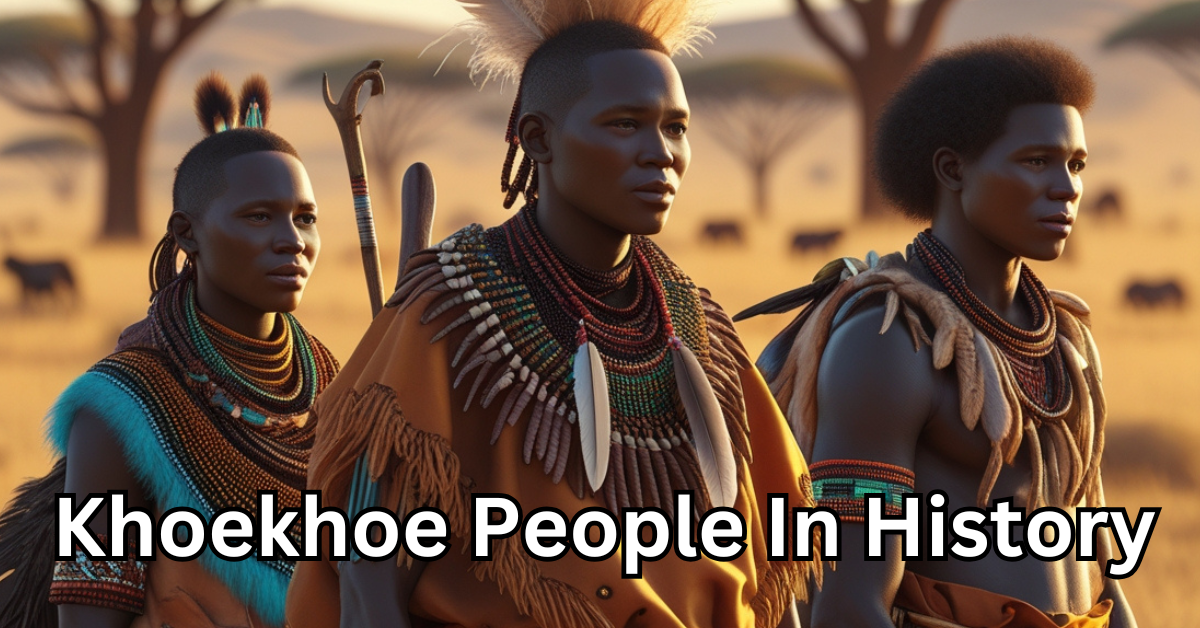Khoekhoe
The Khoekhoe are an indigenous people of Southern Africa. Early European explorers encountered them in the hinterlands, and today they primarily live in European settlements or official reserves in South Africa and Namibia. The term “Khoekhoe,” meaning “men of men,” is their self-identifier, while the term “Hottentot,” coined by Dutch settlers to mimic the clicks in their language, is now considered derogatory.
The Khoekhoe are divided mainly into two groups: the Nama and the Orlams. The Nama include subgroups like the Bondelswart, Rooinasie, Zwartbooi, and Topnaar. The Orlams encompass groups such as the Witbooi, Amraal, Berseba, and Bethanie. They are closely related to the San people and share many cultural and physical traits.
Historically, war, disease, and integration into Cape Coloured communities have diminished the original Khoekhoe groups. Their traditional economy—based on herding, hunting, and gathering—has largely transitioned to settled lifestyles. Most Khoekhoe now adopt Europeanized modes of living, including material culture and language. Many have converted to Christianity. Traditional social structures like patriarchal family groups and clans have given way to administrative units under chiefs and headmen on reserves.
San
The San, also known as “Bushmen,” are indigenous to Southern Africa, primarily residing in Botswana, Namibia, and southeastern Angola. The term “San” means “bush dwellers” in the Nama language. While historically distinct, the San now blend culturally and physically with neighboring Khoekhoe and Bantu-speaking communities.
Traditional San life centers around small, autonomous bands of 25–60 people, often consisting of extended family groups. These bands interact through trade, marriage, and visits, leading to fluid membership. Leadership is informal, based on skill or age, rather than formal authority.
The San traditionally lived in lightweight shelters made from branches and grass, relying on minimal, portable possessions. Their tools and weapons include bows with poisoned arrows, snares, and spears. They subsist on game, wild plants, nuts, and insects, though diminishing resources increasingly challenge their way of life.
San spirituality varies among groups like the !Kung and |Gui, who believe in two supernatural beings—one a creator and the other linked to sickness and death. Spirits of the dead are acknowledged, but ancestor worship is uncommon. Today, the San population numbers about 100,000, with most in Botswana’s western Kalahari.
Nama
The Nama are the largest Khoekhoe group, living mainly in southern Namibia, with smaller communities in South Africa and Botswana. They make up about one-eighth of Namibia’s population, totaling around 230,000. The Nama language is notable for its extensive use of click sounds.
Historically, the Nama were prosperous pastoralists, herding sheep and cattle. However, intertribal conflicts and wars with the Herero and Germans in the 19th and 20th centuries decimated their numbers. Today, some Nama still graze livestock, but many work as migrant laborers on farms.
Khoisan Languages
Khoisan languages are a unique group spoken primarily in Southern Africa, with a few in East Africa. The term combines “Khoekhoe” (person) and “Saan” (bush dweller) from Nama. These languages are known for their extensive use of click sounds, which have also influenced nearby Bantu languages like Xhosa and Zulu.
Once widespread, many Khoisan languages are now endangered or extinct. Socioeconomic and cultural changes have marginalized these languages, with speakers often adopting dominant languages. A rare exception is the East African Hadza language, which has maintained vitality alongside Swahili.
The origin of click consonants in Khoisan languages remains speculative, with some theories suggesting environmental adaptations. However, their normal linguistic use is as functional as any other consonant. While Khoisan languages share click sounds, they differ greatly in structure and vocabulary, making it challenging to classify them as a single language family.
